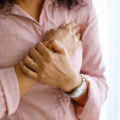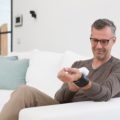Long COVID

Since December 2019, the “SARS-CoV-2” coronavirus (Severe Acute Respiratory Syndrome Coronavirus-2) has been spreading rapidly around the world. This infectious disease, popularly known as COVID or simply coronavirus, is mainly transmitted from person to person by inhaling particles containing the virus. Sufferers release these particles when coughing and sneezing, for example, but also when breathing or speaking1 – in other words: The route of transmission – infection via airborne droplets.
Due to mutations in the virus, there are different variants of COVID, in which the transmissibility and the disease progression may differ.1
Common symptoms include a cough, fever, runny nose, and sore throat, as well as an impaired sense of taste and/or smell.1
Long-term health consequences have also been frequently observed following SARS-CoV-2 infection. The long-term consequences of SARS-CoV-2 infection are referred to as “long COVID.”2
“Long COVID”
The term “long COVID” is the generic term for long-term health consequences that may occur after SARS-CoV-2 infection. Long COVID includes health complaints that persist or emerge four weeks after the acute phase of illness. Complaints that persist for more than 12 weeks after infection with the virus and last for at least eight weeks are referred to as “post-COVID syndrome.”2 According to a World Health Organization (WHO) study, common symptoms include “fatigue, shortness of breath, cognitive impairment, and other symptoms that generally affect everyday functioning.”3
In addition, long COVID patients frequently report respiratory problems, such as shortness of breath and coughing.4/5
What helps to prevent or treat acute symptoms?
In addition to vaccination, maintaining social distance, ensuring good hygiene, wearing masks, ventilating indoor spaces regularly, and using the coronavirus warning app, humidification of the airways has also proven to be a promising preventative approach.6
In an international study, researchers found that dehydration of the upper airways increases the risk of developing respiratory diseases such as COVID-19, asthma and COPD, and inhaling a saline solution reduces the risk.6 Inhaling a saline solution also reduces the release of aerosols, thus reducing the viral load in exhaled air.7
Should respiratory illness occur despite preventative measures, respiratory symptoms such as coughing can be effectively treated with an appropriate inhaler. Please discuss treatment options with your doctor in each case.
The targeted use of inhalers helps to humidify and clear your airways, including when you’re out and about. Thanks to their rechargeable batteries, medisana’s powerful IN 530 and IN 605 inhalers are also perfect for using when you’re on the go.
They offer targeted treatment for diseases of the upper and lower respiratory tract through the nebulisation of liquids and liquid medications (aerosols). The compact inhalers can be used to inhale various aerosols, for example saline solutions, which moisten irritated mucous membranes, thus carrying away allergens and facilitating the typical coughing process. Medically prescribed inhalation solutions can also be used for the targeted treatment of certain diseases. The great advantage of this treatment is that the medication is administered exactly where its effect is needed, namely from the mouth-nose-throat area to the lungs. Thanks to their innovative micro-compressor technology, medisana’s IN 530 and IN 605 inhalers have a high degree of efficiency, and are particularly effective due to their high proportion of respirable aerosols.
In addition, the phenomenon of “silent hypoxemia” has also been observed in COVID-19/long COVID patients. Despite reduced oxygenation, patients do not feel short of breath. They can walk, enjoy themselves, eat, and drink without any problems and without noticing the decreased oxygen saturation in their blood. 8
A pulse oximeter can be used to quickly check whether your oxygen saturation and heart rate are within the appropriate range. Pulse oximeters are non-invasive and completely painless to use, meaning that you can take a quick reading at any time.
We recommend the medisana PM 100 connect pulse oximeter to measure blood oxygen saturation (Sp02%) and heart rate (pulse rate). Simply place the small, state-of-the-art pulse oximeter on the end of your finger. Within a few seconds, your heart rate and oxygen saturation will be displayed. Once you have measured your blood oxygen and pulse rate, the readings are sent via Bluetooth® 4.0 to the VitaDock+ app for iOS and Android and to VitaDock® Online, where you can store your personal health measurements and gain a better insight into your current state of health.
All medisana inhalers and the pulse oximeter are certified medical devices that are subject to strict requirements and regular inspections.
COVID-19 product recommendations
Preventative: Inhalers, RM 100 protective face masks (category FFP2)
During the infection:Inhalers (e.g. IN 605 inhaler, IN 530 inhaler), pulse oximeters, thermometers
List of references:
Source 2: https://www.rki.de/SharedDocs/FAQ/NCOV2019/FAQ_Liste_Gesundheitliche_Langzeitfolgen.html
Source 3: World Health Organization (2021). A clinical case definition of post COVID-19 condition by a Delphi consensus, 6 October 2021. World Health Organization Regional Office for Europe. https://apps.who.int/iris/handle/10665/350195. Licence: CC BY-NC-SA 3.0 IGO
Source 6: George, C.E., Scheuch, G., Seifart, U. et al. COVID-19 symptoms are reduced by targeted hydration of the nose, larynx and trachea. Sci Rep 12, 4599 (2022). https://doi.org/10.1038/s41598-022-08609-y




